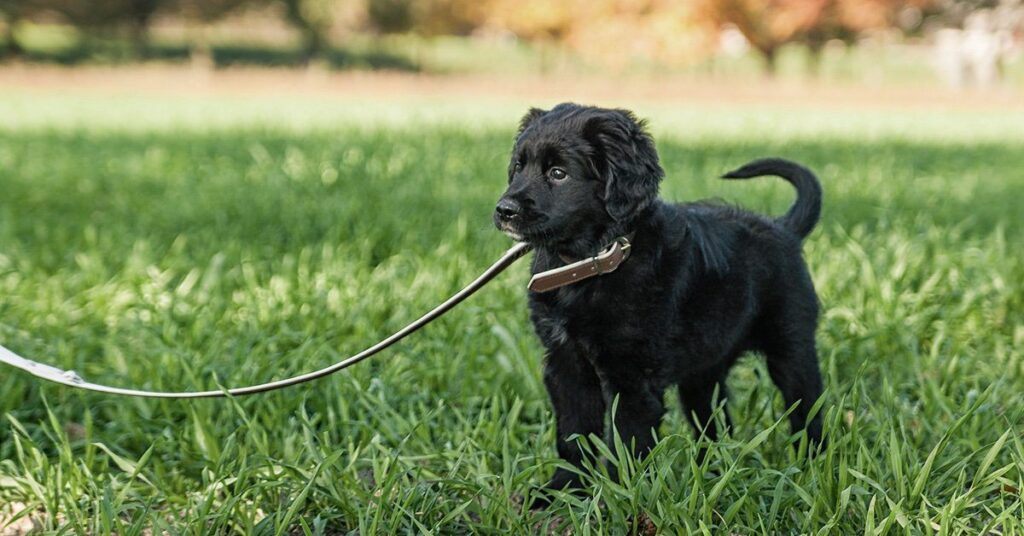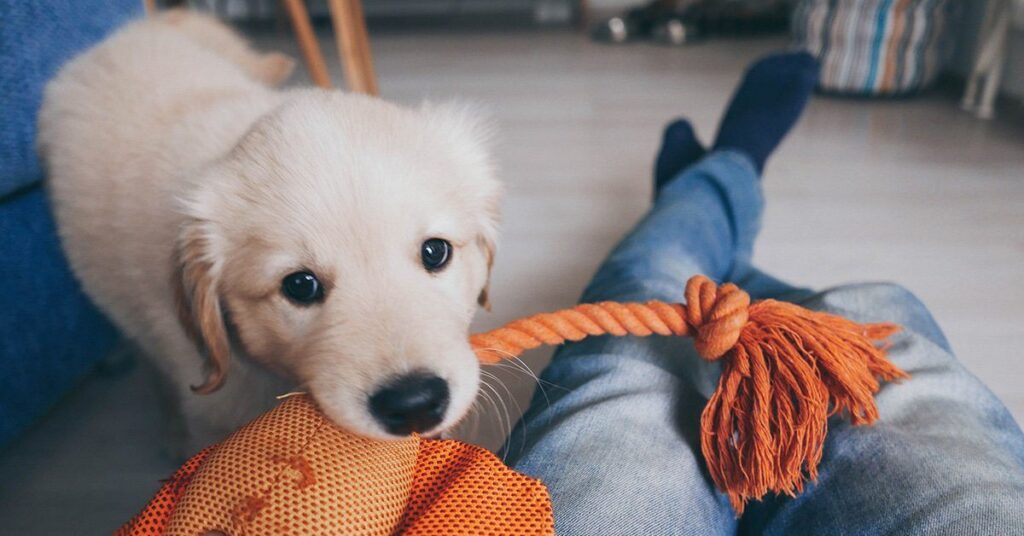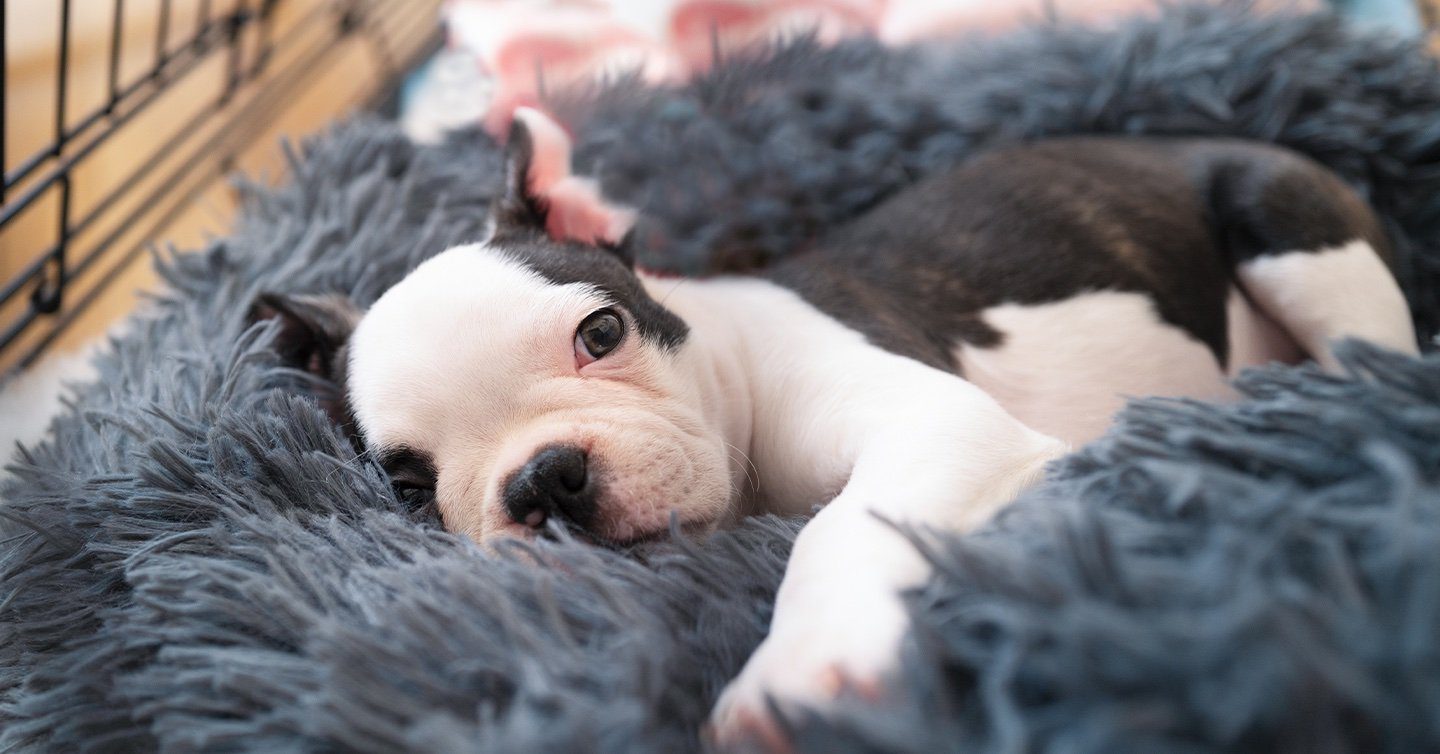Bringing a new puppy home is an exciting yet challenging time, filled with enormous responsibility. If you have a million questions about those first few days, don’t worry – we’ve got you covered!
In this article, we’ll cover how to prepare and what to expect before you bring your puppy home for the first time. Let’s dig in!
Preparing for puppy’s first night
Most puppies go to their new homes when they’re eight to ten weeks old, and their world changes in an instant. Until now, they’ve been snuggled up with their mom and littermates. Suddenly they’re in an unfamiliar place surrounded by unfamiliar smells, noises, people, and perhaps other animals.
As your puppy gets used to their new environment, you’ll encounter lots of whining, howling, crying, and barking. But fear not – this is normal behavior for a young puppy and as they settle in, this behavior will stop.
To help your puppy adjust and gain confidence, here are some tips to help them feel comfortable and safe those first few nights.
1. Give them a comforting blanket or towel
When you go to pick up your pup, bring a blanket or towel to pick up the scent of their mom and littermates. Giving your pup a cozy blanket will not only make them feel comfortable and safe, but also help soothe those puppy cries with a familiar scent. Some breeders will even provide a piece of Mom’s bedding, if you ask.
2. Set up a safe puppy zone
You’ll want to create an area that’s safe for your puppy to play and sleep without getting into trouble. Enclose the puppy zone with a small playpen, or gate the area off. It should be large enough to hold all of their belongings and accommodate some independent playtime.
The puppy zone should contain lots of puppy toys, a bed, a pee pad, their crate, and food and water. Note: Young puppies sleep about 15-20 hours per day, so it’s important you set up their puppy zone in a quiet place so they can rest.
3. Stock up on food
A puppy’s digestive system is still developing, which means they can get an upset tummy from many things. To avoid surprise vomiting or diarrhea, it’s best to keep feeding them the same puppy food they’ve been eating. Most breeders will send them home with some food, but if not, be sure to consult your vet on the best puppy food to start them on.
4. Puppy-proof your home
Unlike adult dogs, puppies explore their world through their mouths. Remove any hazards by picking up small objects they can chew on or swallow, moving electrical cords, poisonous plants, and anything else that might cause injury.
5. Prepare your car for safe puppy travels
How will you travel with your new puppy? There’s tons of great travel gear for dogs out there, but a crate is always your best option. It keeps your puppy from becoming a projectile in the event of an accident or quick stops and provides a safe space to observe the new world around them. Put a blanket or pad in the crate so your puppy can snuggle up to take a nap if needed.
6. Bring a co-pilot along
Bringing along a friend or family member to keep your puppy company can provide them reassurance during the drive home. For long drives, provide bathroom breaks or bring some doggy diapers. These little ones will need to go often, especially when anxious!
7. Shop for puppy supplies
There are loads of puppy supplies to check off your new puppy checklist. Some basics are food and water bowls, a leash, and a collar or harness, toys (chew toys, snuggle toys, balls, tug toys, etc.), a dog bed or a puppy crate (room enough to stand up, turn around, and lay down in), and training treats.
8. Don’t forget about puppy insurance
New puppies get into lots of trouble in their early days, which can lead to accidents and injury – and vet bills are expensive! Having pet insurance can save you an arm and a leg, but too many new puppy owners realize this too late. To ensure your pup gets the best care no matter what, it’s smart to get pet insurance as soon as possible.
The day to pick up your puppy finally arrives! Here’s what you can expect, and how to make your new puppy’s first day the best it can be.

Puppy’s first day at home
The first 24 hours with your puppy can be as challenging as they can be fun. You’ll have some OMG! moments, some accidents, and loads of hilarious antics. However, the first 24 hours is also your opportunity to begin setting the foundation for your life with your new canine companion.
Those first days and weeks with your new puppy are all about bonding, establishing a routine, building their confidence, and avoiding bad habits. Your puppy will need lots of physical activity, training, and a healthy dose of patience and love.
Let’s dive into the play-by-play of your puppy’s long-awaited arrival.
Arriving home
As soon as you get home, take your puppy to their designated potty area and set them down. Say their name and whatever word or phrase you plan on using for potty training, such as “Go potty.” Give them some time to wander and sniff around (they won’t go far). It can take up to 15 minutes for your pup to figure out what they’re supposed to be doing. When your puppy finally pees or poops, give them lots of praise.
After your puppy has taken care of business, let them inside to roam around the house. They should sniff out their new environment, but keep a close eye on them at all times.
Feeding them
Your puppy will appreciate a small meal when they first arrive home. Anxiety can create a tummy ache, so offering a tiny meal will solve a hunger problem without an upset stomach. Some puppies do well with four to six meals a day at first, whereas others are fine with three to four. Regardless of where your puppy falls, be sure to follow dietary recommendations and start getting them into a regular feeding schedule.
Pro tip: You can also use kibble as training treats to avoid any tummy troubles.
Meeting the family
Kids get very excited when a new puppy arrives, and rightfully so! Plan on supervising their playtime for a while until your kids learn how to safely interact with their new pup.
Puppies like to chew, nip, and bite when exploring or playing, so it’s important to help your children understand this natural behavior. Be sure they know to leave the puppy alone when it’s overexcited or scared to avoid behavioral issues or injury.
Note: Small children should learn to hold the puppy while sitting. It’s never a good idea for a small child to carry a puppy.
Meeting the other pets
If you have other household pets, it’s very important to socialize them early on. Your other pets may not welcome your rambunctious new puppy at first. If they’re territorial, they may growl, snarl, or ignore the puppy. During those first days and weeks, it’s a good idea to separate them and let them play for only short amounts of time.
The puppy zone will especially come in handy in this instance. Giving your new puppy and your other pets space from each other can help their relationship safely progress.
Don’t forget regular bathroom breaks
Young puppies have underdeveloped bladders. Some will need to pee every hour, and others will need to pee every 15-30 minutes. Nerves and anxiety will play a role in how frequently your puppy needs a bathroom break, too. Setting 30-minute alarms on your phone can help you avoid accidents.
Routine times to take your puppy for potty breaks are:
- First thing in the morning
- After meals
- After a nap
- After playtime
- Before bedtime
You’ll learn your puppy’s cues, and potty training will happen if you remain consistent with the routine and potty areas.
Always reward your puppy when it pees or poops outside and clean up any accidents inside without comment. Puppies don’t distinguish between good and bad attention, so discipline, when an accident happens, can confuse them. Cuddles and treats for good behavior go much farther!
Limit Visitors
Though you want to show off your little one to the world, the first days after your puppy arrives are not the time for visitors. In fact, until your puppy is vaccinated, you should avoid public places and strangers as their immune system is very fragile. A lot of people make the mistake of taking their puppies to the dog park too early and risk exposure to parasites and illness.
Before you know it, it’s nighttime. What now?

Puppy’s first night at home
Your puppy’s first day will likely fly by, and before you know it, it’s time for bed. Here are a few tips for bedtime on night one.
Where is the best place for your puppy to sleep?
Your puppy will sleep better if you provide a puppy bed or crate within range of your sight and smell. Without mom and siblings, you are your new puppy’s family, so they’ll find comfort in your presence at night.
Crate or puppy bed?
A crate works well to keep your pup calm and prevent them from wandering or relieving themselves while you sleep. It also provides a cozy area for your puppy to relax during the day and take those important naps. A bed won’t prevent wandering and accidents during the wee hours of the night.
Can your puppy sleep with you?
As hard as it might be to resist those puppy cuddles, you shouldn’t let your puppy sleep with you – especially before housebreaking is complete. Puppies wake up during the night and can be restless. If on a bed, they can fall off and injure themselves. Trust me, when they wake up, they’ll let you know by barking and whining.
There are two common scenarios for a puppy’s first night:
- Your puppy will whine a little (remember this is how it calls mom to provide comfort), then settles in for a few hours to sleep. If this is your puppy, you are lucky! Not all puppies do this and can keep you awake for a few days until they adjust.
- Your puppy has a hard time adjusting to life without mom and siblings. The puppy whines, cries, and barks all night long. Not a pleasant scenario, but it’s not unsolvable either.
Here are some training tips if your puppy won’t stop crying in their crate:
- Place the blanket or towel with Mom’s scent inside the crate to calm your puppy down. The familiar smells will help them relax and fall asleep, especially the first week.
- Provide a plush, snuggly toy for your puppy to curl up with. Puppies sleep curled up with their littermates, so a good toy can simulate this experience. Amazon carries some plush toys with heartbeats for times like these.
- If those tricks don’t work, you need to establish a bedtime routine. This can take a couple of days. When your puppy won’t settle down, take them out to potty.
Potty breaks happen in the middle of the night too!
During the night, your puppy will need potty breaks. As soon as your pup wakes up during the night, take them outside for a potty break and return them to the crate. Don’t treat them to enter the crate, or play with them. This is quiet time and your pup will learn to sleep through the night soon.
Take your puppy out for a bathroom break as soon as it’s time to wake up in the morning. Allow for wandering and sniffing to find the right spot. Your puppy will stay close to you as long as you remain in the potty spot.
Should you leave a puppy to cry in the crate?
Leaving a new dog or puppy to cry during the night is not a good idea. It’s heartbreaking and causes extreme distress to both you and your puppy. They will settle in after a few days. However, until your puppy is comfortable, don’t leave them to cry and whine without checking in every once in a while. It can cause behavioral issues like separation anxiety later on.
Puppy parenting is not easy, but it’s worth it
Your puppy’s first days with you are about creating a bond, establishing routines, and building confidence. It’s an enormous responsibility but comes with enormous rewards.
Exercising patience, establishing consistent routines, and being persistent with training can help your new puppy build the confidence they need to become the canine companion of your dreams.
New puppies can get into lots of trouble and mischief – which can sometimes mean surprise visits to the vet. Puppy insurance can help you pay for the cost of treatment when accidents happen, which is why there’s no better time to get protection than the early days of puppyhood.
*Pumpkin Pet Insurance policies do not cover pre-existing conditions. Waiting periods, annual deductible, co-insurance, benefit limits and exclusions may apply. For full terms, visit pumpkin.care/insurancepolicy. Products, discounts, and rates may vary and are subject to change. Pumpkin Insurance Services Inc. (Pumpkin) (NPN#19084749) is a licensed insurance agency, not an insurer. Insurance is underwritten by United States Fire Insurance Company (NAIC #21113. Morristown, NJ), a Crum & Forster Company and produced by Pumpkin. Pumpkin receives compensation based on the premiums for the insurance policies it sells. For more details visit pumpkin.care/underwriting-information and pumpkin.care/insurance-licenses.




